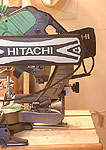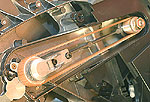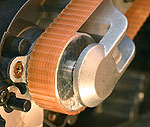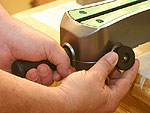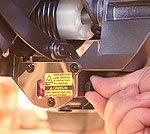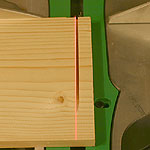This is a Veteran Owned site
![]()
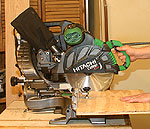 |
Solid construction, large cutting capacity and zero-clearance at the rear make this an SCMS that fits many woodworkers and contractors needs. Click image to enlarge |
Hitachi C 12RSH, 12” Sliding Compound Miter Saw
Finally! A functional space-saving design!
Text & Photos by Tom Hintz
Posted - 5-13-2006
Since first coming on the market, the attraction of the SCMS (sliding compound miter saw) was the cut width capacity that rivaled radial arm saws with similarly sized blades. Until now, the guide rails that enabled this capacity jutted to the rear of the saw, substantially increasing its footprint. For space-challenged woodworkers and contractors working on site, having to place the SCMS 18” (or more) from a wall or other obstruction ate into valuable floor/work space. The Hitachi C 12RSH incorporates new engineering that cures this problem without sacrificing cut-width capacity.
The Concept
(Top) The Hitachi C 12RSH is truly zero-clearance on the back side. (Bottom) This unique guide rail design means you don't have to place this saw an arms length from the wall! Click images to enlarge |
While the engineering behind the design of the Hitachi C 12RSH was undoubtedly challenging, the result for the user is surprisingly simple. All SCMS have a knob that locks the saw’s power head on its guide rails. The Hitachi C 12RSH has a second locking knob that represents the major difference over traditional SCMS designs.
The Hitachi C 12RSH guide rails move within two sets of bearings, each with its own locking knob. The ball bearings through which the guide rails slide are mounted in 3 7/8”-wide housings that provide good separation of the bearing points for maximum stability. The user can lock the saw’s head to the rails, or the rails to the saw’s frame and do either (or both) at any point on the rails. The guide rails can be allowed to extend to the rear when space is not a problem, or locked fully forward, allowing the Hitachi C 12RSH to be placed very close to an obstruction without sacrificing cut width capacity.
Hitachi could have used a fixed rear guide rail mount and saved a bunch of manufacturing dollars, but providing two locking points affords the user versatility not found on traditionally designed SCMS.
Power & Drive
A stout 15-amp (1850W) motor that features replaceable brushes drives the 12” -diameter (1” bore) blade. Exterior, screw-in brush caps allow replacement in the field. Maximum blade speed is 3800 rpm.
All that power is transmitted to the blade via a serpentine-style poly belt that runs on pulleys with machined grooves that interact with ridges on the belt to keep it running true. Using a drive belt allows mounting the motor up high so it does not interfere with large stock and makes for a very smooth-running saw.
The blade pulley assembly incorporates a push button lock that makes changing blades a one-wrench job. (Hitachi supplies that wrench with the Hitachi C 12RSH) This pulley is subjected to substantial loads so to insure its stability, Hitachi added an outboard support to the shaft. That support, also equipped with a ball bearing goes a long way towards insuring a long life for the entire assembly and the accuracy they control when cutting wood.
Cut Capacities
Despite the unique design of the space-saving sliding rails, the Hitachi C 12RSH retains the maximum cutting and miter capabilities we expect in a 12” saw. Set at zero on both the miter and bevel scales, the Hitachi C 12RSH will cross cut a 4 3/16”-thick by 12 ¼”-wide piece of wood. That capacity shrinks to 8 5/8” maximum cut width at a 45-degree miter (zero bevel) to the left or right.
Lay the Hitachi C 12RSH over to a 45-degree bevel to the left (zero miter) and it will cut a 2 ¾”-thick by 12 ¼”-wide piece. That same bevel cut to the right will handle a 1 ¾”-thick by 12 ¼”-wide piece.
Compound cuts are also substantial. With the Hitachi C 12RSH set to 45-degrees left bevel and 45-degrees left miter, it cuts a piece 2 ¾”-thick by 8 5/8”-wide. At a 45-degree right bevel and 45-degree right miter it still cuts a piece 1 ¾”-thick by 8 5/8”-wide.
Mixed compound cuts, often used to cut things like crown molding changes things somewhat though capacity is still more than most of us will ever need. At a 45-degree left bevel and 31-degree right miter, a 2 ¾”-thick by 10 7/16”-wide piece can be cut. With a 45-degree right bevel and 31-degree left miter that goes down to 1 ¾”-thick by 10 7/16”-thick.
Miter indents are located at 15°, 22.5°, 31.6°, and 45° to either side of zero. Miter angles max out at 46-degrees left and 57-degrees right. The bevel range is 0 to 45-degrees to the left and right.
Table and Fence
The material support table is 22 ¾”-wide with a maximum of 5 ½” of depth in front of the fence. The turntable arm reaches a full 27” in front of the fence to provide more than adequate support to the work piece where the cut is being made. The turntable arm has plastic inserts on both sides of the blade that can be adjusted in or out as needed to produce a near zero-clearance insert around the blade at all angles.
The fence runs the full length of the table and is 4 ½”-tall at its highest point. Again, this is more than enough for most cutting jobs, including working with most crown molding.
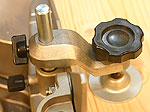 |
The included work hold down clamp is easy to use and can be installed on either side of the fence. Click image to enlarge |
Rather than use moveable fence halves, the Hitachi C 12RSH incorporates swing out sections on each side that increase the fence width a total of 12” while clearing the center of the fence for steep bevel cuts.
A nicely designed work clamp is included and can be mounting in bosses cast into both sides of the fence. Installing and adjusting the clamp is tool-free thanks to finger operated knobs that control height. A 1 ¾”-diameter knob on a threaded shaft allows clamping the work piece securely with very little effort.
Hitachi offers a specially designed clamp and work supports that hold crown molding when it is leaned against the fence for cutting. Also available are slide-out extenders to increase the left and right capacity of the table for cutting longer stock.
Controls
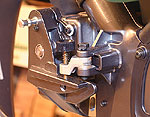 |
In addition to the bevel and miter controls, a flip-out depth stop with finger setting makes those cuts easy and fast. Click image to enlarge |
All handles and knobs used to operate the Hitachi C 12RSH are large and easy to use. Though the handle for operating the saw is fixed, its size, shape and felt comfortable in all of the situations we encountered.
While miter and bevel angles can be set manually by swinging the power head to the desired position, the Hitachi C 12RSH also provides geared knobs that make it very easy to “dial in” very specific angles before locking. Miter locking is accomplished by turning the handle at the front of the saw while bevel locking is done with a large, 5 ½”-long lever at the rear. The length of this handle makes it very easy to lock the bevel angle even though you have to reach back there to do it.
Easy to adjust stops are provided at either end of the bevel range. The Hitachi C 12RSH also features an adjustable depth of cut stop that can be swung in or out of position as needed. The cutter head can also be locked in the down position with a push-pull pin for transport.
The saw is controlled by a trigger-style On/Off switch in the handle. The trigger is located well and large enough to be used with gloves on. It also has a noticeable detent that makes accidental operation unlikely.
Laser
The Hitachi C 12RSH features an AC-powered laser alignment guide that is controlled by its own switch. Aside from not having to deal with batteries, being able to turn the laser on or off when desired is a safety feature because the cut can be aligned to the laser without having to power up the blade as with the more common centrifugally actuated washer-type lasers. The laser is projected onto the wood over the full length of the table arm with the saw in the full-up position, allowing the operator to use both hands to position and clamp the wood in place before making the cut.
The brightness of the Hitachi laser is exceptional. Even under our photographic lighting, it remained very easy to see. It also remains tightly focused over the full length of the table arm.
The laser is fully enclosed in a housing to protect it from dust and flying debris. An external knob makes aligning the laser a very easy task and one that can be done in seconds on the job without having to take anything apart or find a tool. Though we only had to align the laser once during our evaluation, correcting it should it go off mark takes seconds.
There is enough adjustment range to allow the laser line to be placed where the operator is most comfortable. I like the laser just to the left of the cut but it can placed in the center or to the right of the cut just as easily.
Dust Collection
Though generally not the high point of a SCMS, the Hitachi C 12RSH does an exceptional job of directing dust into a chute built into the rear of the blade housing. A zip-open catch bag is included and attaches with a no-tools spring retainer.
Early in our testing we began noticing a lack of dust around the Hitachi C 12RSH as compared to most other SCMS tested. We found that missing dust in the catch bag that had to be emptied several times, demonstrating that this system actually works better than many we have seen.
In the Shop
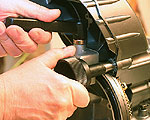 |
As with miter adjustments, the bevel angle can also be set using a very precise dial. Click image to enlarge |
We began evaluation of the Hitachi C 12RSH by checking the alignment of the fence to be sure it was 90-degrees to the blade and the table surface. Both proved to be perfect. We also checked the accuracy of the stops by measuring the blade to fence angle at 22 ½ and 45-degrees on both sides of zero on the miter scales. Those proved to be right on the money. In fact, the only adjustments we had to make was at the left 45-degree bevel stop that was approximately ½-degree off as the Hitachi C 12RSH came out of the box and the miter indicator arrow that was also slightly off.
To check the laser, a piece of wood was clamped onto the table and a shallow cut made in its surface. When the laser was turned on we found it was spaced to the left of the cut approximately 1/16”. A quick turn of the adjusting dial corrected that in just a few seconds. Throughout our evaluation, the laser never required further adjustment.
Video Tour! |
The Hitachi C 12RSH comes with a 60-tooth, 3/32”-wide, carbide-tipped blade that did a very good job in all materials we cut with it, including hardwood veneer and laminate-covered stock. All cuts were clean, true with crisp edges that showed virtually no chipping. The blade cut all stock easily, never taxing the motor to the point that we could hear a change in rpm.
Despite being a narrow kerf design, the blade also cut steep bevels cleanly. There was no wandering or deflection that could be found by checking the pieces cut and a high-precision straight edge.
I have not had a 12” SCMS in the shop before and was surprised at how useful the additional cut capacity turned out to be. The Hitachi C 12RSH handled most of the jobs that used to be done on my old radial arm saw, only without the frequent re-alignments. Capacity, accuracy and portability are prime reasons 12” SCMS are quickly gaining popularity with small shop woodworkers. Put the Hitachi C 12RSH on a commercial or shop-built mobile stand/cabinet and it is capable of handling a huge range of cutting jobs in and out of the shop. Plus, it doesn’t eat up precious floor space.
Conclusions
The Hitachi C 12RSHH is a well-built, cleverly designed tool that brings a full set of capabilities and cutting capacities to woodworking shops or the job site for contractors. The unique space-saving sliding mechanism works very well and will prove crucial to many woodworkers and contractors who can ill afford sacrificing floor space.
The street price of $701.02 (5-12-2006) certainly is not chump change for most of us but the extensive list of capabilities and small space requirements make it an economic alternative to machines costing far more. Designed with contractor use in mind, the Hitachi C 12RSH will serve a woodworker for many years making this a long-term investment that will also pay dividends in the quality of the projects made with it.
Visit the Hitachi web site - Click Here
Have a comment on this review? - Email Me!
All written, photographic and drawn materials are property of and copyright by NewWoodworker.com LLC 2000-2019. Materials may not be used in any way without the written permission of the owner.

